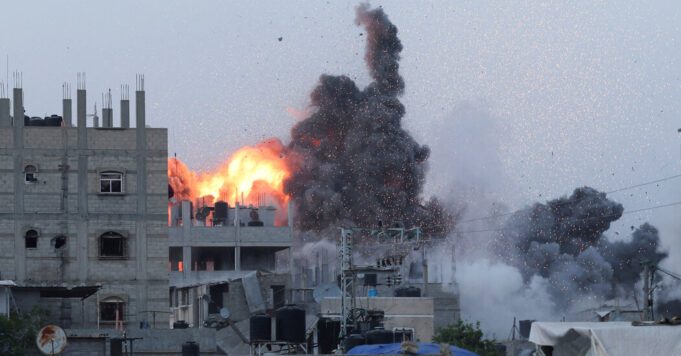Although Hamas and the Israeli government appear to be inching closer to a ceasefire agreement, analysts remain deeply skeptical that the two sides will implement the agreement beyond a temporary ceasefire.
At issue is a three-phase deal proposed by Israel and backed by the United States and some Arab countries that, if fully implemented, would eventually include the total withdrawal of Israeli troops from Gaza, the return of all remaining hostages from the Oct. 7 attack and a reconstruction plan for the region.
But reaching the finish line is impossible if the parties are unwilling to start the race and agree on the end point. Fundamentally, the debate is not just about how long the Gaza ceasefire should last or when it should be implemented, but whether Israel can accept a long-term ceasefire as long as Hamas retains considerable control.
If Israel agrees to Hamas's demands for a permanent ceasefire from the outset, it would have to acknowledge that Hamas will not be destroyed and will play a role in the future of the territory, something the Israeli government cannot tolerate. Hamas, on the other hand, says it will not consider a temporary ceasefire without the guarantee of a permanent ceasefire that can effectively ensure its survival, even at the cost of countless Palestinian lives, or Israel will restart the war after the hostages are repatriated.
However, after eight months of grueling war, there are signs that the two sides may be approaching the first phase of the plan: a six-week conditional ceasefire. Analysts say that while that step is hard to secure, the second phase of the plan – a permanent cessation of hostilities and a full withdrawal of Israeli troops from Gaza – is even less likely.
Natan Sachs, director of the Brookings Institution's Middle East Policy Center, said: “It would be a mistake to view this proposal as a stopgap measure. Most importantly, the plan does not answer the fundamental question of who will rule Gaza after the conflict. This is a ceasefire plan, not an afterthought plan.”
Hamas leaders and the government of Prime Minister Benjamin Netanyahu are considering what the deal means not only for the future of the war but also for their own political futures. In an effort to gain support from skeptical partners for the first phase of the plan, Mr. Netanyahu has been particularly willing to keep promises about subsequent phases vague.
Influential figures in each camp are willing to prolong the war. Some within Hamas say the group, dominated by those still in Gaza, such as local leader Yahya Sinwar, should not agree to anything that does not immediately provide a permanent ceasefire. In Israel, the mere mention of an end to the war and a full withdrawal has led Netanyahu’s far-right allies to threaten to overthrow his government.
At a news conference on Tuesday, Hamas spokesman Osama Hamdan said Hamas would not approve the deal if it did not begin with a commitment to a permanent ceasefire and include a full withdrawal of Israeli troops and a “serious and real deal” to exchange remaining hostages for more Palestinian prisoners held in Israel.
“It’s clear to everyone that this proposal is primarily political,” said Shlomo Brom, a retired brigadier general and senior fellow at the Institute for National Security Studies.
“The first phase is good for Netanyahu because some of the hostages will be released,” Mr. Broom said. “But he will never get to the second phase. As before, he will find faults in what Hamas did, and it’s not hard to find.”
100 hostages in A restrictive agreement reached last NovemberThe war lasted about a week. Netanyahu said Hamas had not handed over all the female hostages it had promised, while Hamas said Israel had rejected other options. After the ceasefire expired, Hamas fired rockets into Israel. The war has continued since then.
Nor is there a guarantee this time that phase 1 will be followed by phase 2. Analysts agree that this may suit Mr. Netanyahu just fine, as he placates the Americans with a temporary ceasefire and increased aid to Gaza while finding reasons not to go beyond the deal.
Analysts say Netanyahu hopes Hamas won’t agree to the proposal at all so he can get out of the way. As hostilities with Hezbollah in the north heat up, he has hinted to allies that the second phase of talks can go on indefinitely, even if he has to agree to the Gaza proposal.
President Biden announced the plan at the White House last week. He has his own political considerations and hopes to get both sides to agree as soon as possible. Aaron David Miller, a Middle East expert at the Carnegie Endowment, said Biden obviously wants to stop the Gaza war before the November presidential election, adding: “The only one who is really anxious is Biden.”
Biden therefore urged Netanyahu and Hamas to quickly accept the deal.
As Israeli troops reached the Egyptian border and the main operations of the war wound down, the president said Hamas was no longer capable of launching an attack like the one on Oct. 7 and urged Netanyahu to publicly accept his own proposal.
Netanyahu has done his best to confuse everyone about his intentions, denying that his goal of disbanding Hamas has changed and refusing to support a permanent end to the fighting, which he called Sunday “impossible.”
Biden also stressed that Hamas “should accept the agreement”, but Hamas has not yet accepted it, only expressing a “positive” attitude towards the proposal.
Biden and his officials explained that the proposal three phases.
In the first phase, the two sides will observe a six-week ceasefire. Israel will withdraw from Gaza's main population centers and release some hostages, including women, the elderly and the wounded. The hostages will be exchanged for hundreds of Palestinian prisoners and detainees, whose names are still to be agreed upon. Aid will begin to flow into Gaza, with up to 600 truckloads a day. Displaced Palestinian civilians will be allowed to return to their homes in northern Gaza.
In the first phase, Israel and Hamas will continue negotiations to reach a second phase agreement: a permanent ceasefire, a complete withdrawal of Israeli troops from Gaza, and the release of all remaining hostages. Biden said that if the negotiations take more than six weeks, the first phase of the ceasefire will continue until the two sides reach an agreement.
If they actually do that.
Israeli officials, starting with Mr. Netanyahu, have insisted that Israel must retain security control over Gaza in the future, so they are unlikely to agree to a full withdrawal of Israeli troops from the buffer zone they have established inside Gaza. Even if they agree, Israel insists on the right to move in and out of Gaza as it deems necessary to combat remaining or re-established Hamas or other militants, as it does now in the West Bank.
As one former senior intelligence official put it bluntly: “There is no good solution here, and everyone knows it.”
Stopping the war without ensuring that Hamas won’t return is a real dilemma, he said. But is it realistic to expect that continuing the war will achieve that goal? Releasing the hostages is a priority — an estimated 125 people are still being held by Hamas and other armed groups in Gaza, and although dozens are believed dead, it is unclear whether continuing the war would increase pressure on Hamas to reach a deal to free the hostages or put those still alive in further danger. And even if Israel were to stop the war after so many months of captivity, releasing the hostages might take more time than it already does.
The timing also favors a phase one deal as Israel fights to complete military control of Gaza’s southernmost Rafah and the Egyptian border. Under U.S. pressure, Israel has begun the battle with fewer troops, less bombing and more care for civilians, and Israeli officials say the battle is expected to take another two to three weeks, roughly the time it took to negotiate the first phase of the ceasefire.
Israeli forces are slowly moving into more densely populated areas of Rafah city, forcing civilians to evacuate westwards towards the coast and officially designated safe zones, where civilians continue to die from Israeli attacks, even though shelter, water, food and health care are basic at best.
According to Israeli officials and the Institute for the Study of War, Tracking Conflicts“Israeli forces continue to conduct clearing operations” and “intelligently based targeted operations” in central Rafah. They raided what Israel called “active combat complexes” on Monday and carried out drone and air strikes on what it called “Hamas weapons production sites in Rafah.” Hamas fighters responded with mortars, roadside bombs and rocket-propelled grenades along the border.
With Hamas militants effectively dismantled and fighting almost entirely in small units, Israel could declare an end to the main war in Gaza while continuing to fight Hamas and other militants wherever they emerge or concentrate, opening the way for a temporary ceasefire, analysts say.
“Israel did a lot of things, and Hamas was significantly weakened,” Sachs said. But Israel did nothing to govern Gaza after its troops left.
Mr. Brom agreed that the Israeli army had made real progress. “My understanding,” he said, “is that the military and terror capabilities of Hamas have been significantly weakened.” Declaring victory is always difficult in such an asymmetric conflict, he said. “Have we defeated ISIS? It’s still there and it’s still functioning,” but it’s been greatly weakened.
Analysts say Netanyahu has refused to decide who or what will rule Gaza if not Hamas, despite constant urging from the United States.
“This is supposed to be an integrated political and military strategy, but the political dimension is completely missing,” Mr. Broom said. “We can stop Hamas from ruling Gaza, but who’s going to replace them? That’s the Achilles’ heel of the whole operation.”




